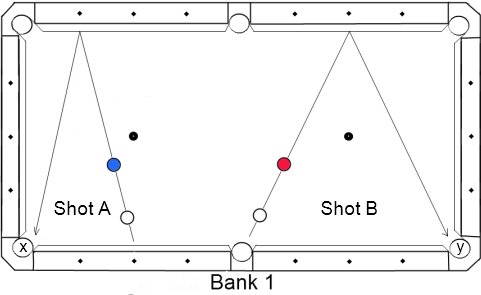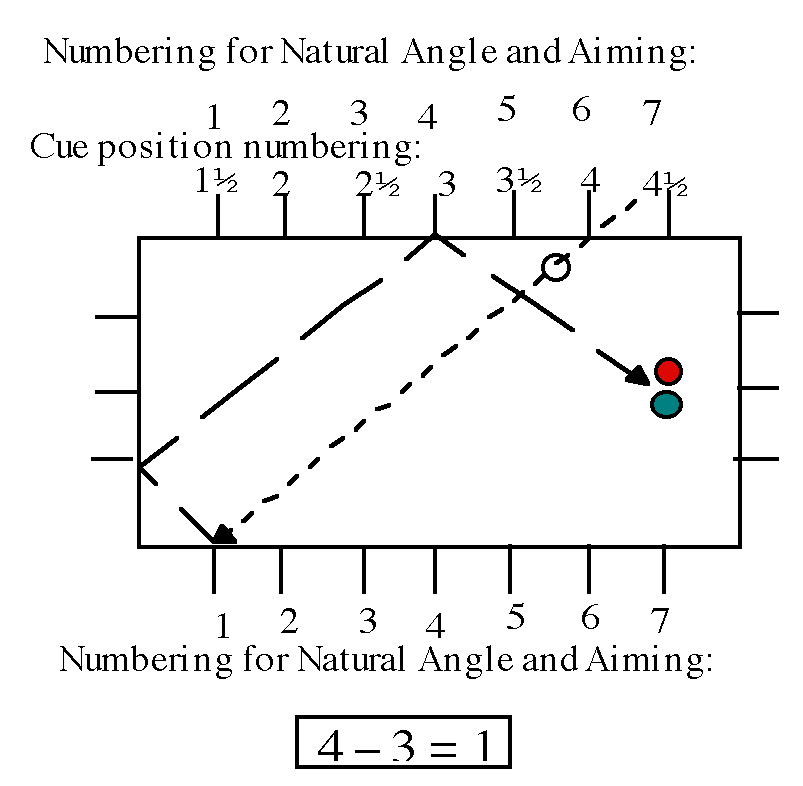Billiards Diamond System
The billiard table diamond system always sparks debate over whether it is a legitimate aiming system. Most billiard tables have diamond spots, and many beginners wonder what they are for. There are many different versions of the diamond aiming system. Here you will learn about the common elements of all billiard diamond aiming systems. You will also learn the basic fundamentals of using the diamond aiming system and we'll describe how the diamond system can help improve your aiming accuracy and your overall pool game.
Billiards Diamond System
Use of the diamond system varies. The players, professional or not, who do learn how to use the diamond system swear by its effectiveness. On the other hand, most professional billiard players don't use it, with one exception: that the majority 3-cushion players use a diamond system of some sort. It can be said that most players generally learn the angles without any assistance from the diamond system whatsoever. This ability is beneficial as your "table layout" at the time may not be in a position where you can benefit from the diamond system.
The Diamond System in Billiards
To begin, here are the basics of using the pool table diamonds for aiming.
There are "invisible lines" going across the pool table from diamond to diamond, forming a grid e.g. the lines go from each diamond on the left side across the table to the corresponding diamond on the right side. (see the diagram below; the dotted lines illustrate the invisible lines.) You can use the diamonds along with the invisible grid as the base of the diamond aiming system.
The Diamond System can be learned by practicing with simple geometry in mind. The general principle is that if you hit the cue ball (or any ball) perfectly straight at one diamond, it will travel completely straight back toward the diamond at the opposite end of the table. If you hit it from ten degrees either way, and it should rebound ten degrees out in the opposite direction. If you find yourself playing a situation where a diamond is not in the appropriate spot, you will have to envision "imaginary diamonds" in the appropriate spot, and the corresponding imaginary grid lines.

It may sound complicated, but you can worked out the general feel with a few hours at the pool table using only the cue ball. By the end of the session, you should have a good feel for how to use the pool table diamonds to estimate rebound angles.
As mentioned earlier, most three-cushion players use a diamond aiming system. Below is a very basic system (with no English used) that some find helpful as a primer to the more complicated diamond aiming systems. Note that the "System" is a personal thing, and diamond systems vary from player to player.
- First, figure out where you must hit the long rail. (...at which diamond on the Third Rail.)
- Next, subtract that from the number two. That number is the number of the diamond where you will need to hit the first long rail using the center ball. For "running english" you will need to add one half of a diamond.
Other than the above, there is not much more you can "learn" without first logging some hours at the table practicing the basics. Once you have done that, you can read some more. Check out the following works, which go in more deep detail on various uses and systems for the pool table diamonds:
- Raymond Ceulemans, who wrote "Mister 100." is said to be the master of the diamond system. This book just recently came back into print as a paperback reprint.
- Robert Bryne wrote a new book called: "Bryne's New Standard Book of Pool and Billiards" and he covers the system in the "billiards" section of the piece.
This covers the very bare minimum basics of the billiard diamond system. As mentioned earlier, there is no substitute for hours logged at the table. Read the basics to get a feel for the general idea, and then get off the internet, and hit the table. Once you have mastered the basics, come on back here and get some more advanced information on the diamond system.
Billiards Diamond System
- Title: Billiards Diamond System
- Author: billiardsforum (Billiards Forum)
- Published: 8/27/2006 2:12:11 PM
- Last Updated: 9/20/2016 3:19:47 PM
- Last Updated By: billiardsforum
Billiards Diamond System
The Billiards Diamond System article belongs to the Billiard Bank Shot and Kick Shot Techniques category. Pool playing tips for making bank shots and kick shots.
Billiards Diamond System Comments
user1241568731 from OR, United States on 5/6/2009 12:12:11 AM
I love how so many authors treat diamond systems as if they were State secrets.
What is desperately needed is a website that lists all of them (I know of six so far) and allows for user additions, and user feedback.
Over time, a wiki of sorts could be built. A one stop website for pool.
snuffy from Lawrenceburg, TN on 6/25/2009 11:29:29 PM
To me the pool table diamonds are used for a reference only. They are a starting point and you adjust from there depending on what English is on the ball and the angle. But there are far to many combinations of English and angle and they vary too much for there to be "a system" that works consistently.
A ball with center english that hits at an angle ends up creating it own english. With practice you can use the diamonds to your advantage for kick shots and bank shots.
Remember that every pool table plays differently so there are no perfect billiard aiming systems out there.
Long Out of Stroke OCMako from Orange County, CA on 8/11/2009 10:42:54 AM
Back in the early 1960's, Montgomery Ward manufactured pool tables and billiard accessories for sale. They were promoted by Minnesota Fats, and he toured the country giving billiard exhibitions on these pool tables at various Montgomery Ward stores.
I was lucky enough to shoot 5 or 6 games of 9-ball with him after the sales pitch at the Santa Ana, CA store.
At that time, he showed me an aiming system where you numbered the diamonds (pool table dots) and the pockets, and then it involved adding and/or subtracting. It was a system he converted from one he learned earlier designed for a 5' x 10' billiard table.
Over the years, I have forgotten the system, but not the "spanking" I got for Minnesota Fats that day.
P.S. Here is an illustration of the numbering of the diamonds as described above:
The details can be found here:
- mathorama.com/geom/lessons/pool_howto.html
brenzter from Dayton, OH on 10/23/2010 7:19:07 PM
I would like to see the 'Diamond System' clearly explained once and for all.
I have been through all of the tutorials by excellent players who know the system, but they are very poor diamond system tutorials.
Those players are professionals in their craft but lack the experience to to pass it on to others by teaching the system thoroughly.
Aramith13 from Greece on 10/6/2011 1:11:08 AM
Rubbish. Who needs the diamond system? If one can't hit the object ball where it should be hit...
First learn how hit the ball, then you will have the experience and will NOT to need to rely on the measurements of the diamond system except for on really difficult shots.
Tee from Mannington, WV on 1/7/2012 9:44:43 AM
I have been playing pocket billiards and carom billiards for 45 years. As a young man I took the initiative to learn the diamond system.
Every pool table plays a little bit different but the diamond system does work. I would urge anyone who is serious about billiards to learn as much as possible about the diamonds and the various diamond systems.
The diamond systems are just another tool at your disposal when you are at the pool table.
MrPhilHarmonic from Freehold, NJ on 3/31/2012 8:09:16 PM
There is a wonderful DVD out featuring the legendary "Hall of Famer" Grady Matthews on the secrets of banking. It takes a bit of fathoming out and is not for the beginner, but once you "get it" it really does make sense. Grady's systems are pretty amazing, featuring 2, 3, and even 4 rail banks!
They are accurate insofar as he uses the Brunswick Gold Crown tables. If you play on Olhausen or Diamond tables, you might have to make tiny adjustments, but his system is so solid that this shouldn't present too many problems though.
Good luck.
Carlos from Minas Gerais, Brazil on 3/5/2014 7:36:28 AM
This explanation was meaningless to me.
Steven L. Guittar from North Chesterfield, VA on 10/8/2014 9:07:53 AM
For the single rail game, there is actually a new method of utilizing the diamonds on the pool table to find the absolute banks points (located via land survey techniques) that were occupied by a mirror image of the surveyed pool table.
Simply put, mirror images are replaced with an aiming stake in the "off-table" location once occupied by a mirror image of the intended pocket. Practice and training is to the surveyed location. Interestingly, the aiming post locations can be found utilizing the "rule of thirds and comeback halves" in conjunction with the pool table diamonds.
You can try this yourself:
The surveyed location for the side pocket aiming post is located as follows:
- 7 foot table: 33" directly out from the center of the center pocket
- 8 foot table: 36.5" directly out from the center of the center pocket
- 9 foot table: 42.5" directly out from the center of the center pocket
Locations are rounded to the nearest 1/2 inch as 1/3000 accuracy is not necessary for a pool table. The pockets are big! Since the actual pocket locations do not change, neither do the surveyed reflections locations change i.e., you can leave the aiming post in place during practice.
"The rule of thirds and comeback halves" sounds convoluted but isn't. It merely defines absolute shooting lanes when the aiming stakes are not present. Observe the intervening rails, the object ball location, and their relationship with the aiming post in location as you practice single rail banks. The lanes and the importance of this fundamental will become readily apparent.
Reply and share your comments below:

